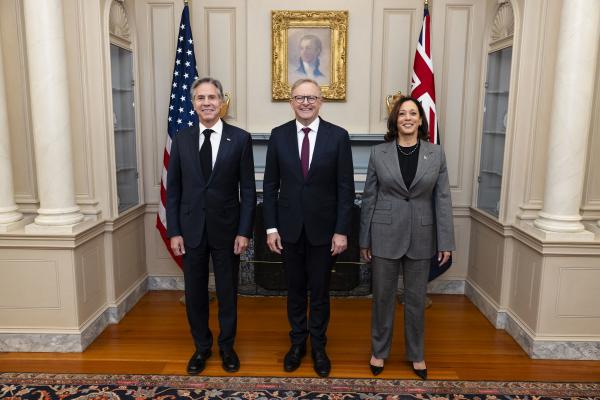Could Australia’s economy survive Trump’s position on China?
Chuck Kennedy - US Department of State / Flickr

James Laurenceson, Director, Australia-China Relations Institute, University of Technology Sydney |
This article appeared in 360info on October 23 2024.
As the US election enters its nail-biting final days, anxiety-riven commentary in Australia is grappling with the potential implications of the outcome.
The selection of Donald Trump, or Kamala Harris is already a unique choice, but the ripple effects for Australia only increase the unease by bringing a third country into view: China.
There are fears US forces in the Asia-Pacific might diminish under either administration, forcing Australia to survive as best it could in a security environment dominated by the People’s Liberation Army.
However, despite the historic, long standing Pacific alliance with the US, when it comes to international trade, Canberra is more aligned with Beijing than Washington.
While China might trigger Australia’s strategic anxiety, there is widespread recognition that it remains Australia’s most important economic partner.
In the US, however, there is now bipartisan political consensus that China is an economic adversary.
Tariffs
The Biden administration has maintained the first Trump administration’s tariffs on Chinese goods adding restrictions on capital and technology flows for good measure.
Earlier this year, Trump floated that his second administration would increase a 19 percent average tariff on Chinese goods to 60 percent across the board.
The US ‘increasingly expects its allies to fall into line‘ when it comes to trade policy and China.
However, at least on this front, several factors combine to support an assessment that some Australian anxieties may be overdone.
For starters, Washington’s coercive instincts towards allies are strongest around cutting off China’s access to advanced technology. This means countries like Japan, South Korea, Germany and the Netherlands have, and will continue to, feel the heat.
In contrast, Australia is a net technology importer, so it will mostly be able to fly under the radar.
Still, Australia can expect US pressure in technology-adjacent sectors, such as critical minerals. Factoids such as each F-35 fighter jet containing around 420kg of rare earth minerals — an industry China dominates but in which Australia has vast potential — are routinely trotted out by the national security commentariat.
Sovereign interests
But here domestic politics are aligned on Australia maintaining its sovereign interests.
In 2015, a request by the Obama administration for Australia to stop selling iron ore to China was dismissed by the Tony Abbott Coalition government as ‘hypocritical’.
A year earlier and not long before he replaced Abbott as Prime Minister, Malcolm Turnbull jibed, ‘I’m sure that we’d love to export vast quantities of iron ore to the United States, but they’ve never shown any enthusiasm in buying them.’
A similar request from Washington today around rare earths or other critical minerals such as lithium would likely be met with the same response and justification by Canberra. Last year, China purchased $13.1b, or 98 percent of Australia’s total exports of lithium spodumene. In contrast, the US bought just $12.1m.
And rather than using policy levers to drive ‘friend-shoring’ with Australia, Washington seems more intent on bringing supply chains onshore.
Instead of relying on Australian supply, the Biden administration has been busy subsidising the development of lithium mines in Nevada. It proudly touts that ‘the US is set to supply more than one-fifth of global demand [for lithium] outside of China by 2030’.
Much of Australia’s critical minerals production is also ineligible to benefit from US subsidies contained in initiatives like the Inflation Reduction Act.
Other US initiatives to attract local excitement include amendments to the US Defence Production Act that list Australia as a ‘domestic source’. But the fine print cruels such hopes: Australia will only be considered a ‘domestic source’ if US demand ‘cannot be fully addressed‘ by companies in North America.
China’s increasing agreement with Australia stretches beyond transactional partnerships.
In three recent cases, both Australia and China agreed to litigate their disputes at the World Trade Organization (WTO) and abide by the independent adjudicator’s ruling. In contrast, when the US loses a WTO case, it declares no intention to comply.
In July, Australia led the shepherding of new WTO rules around e-commerce to a successful conclusion. China signed on, but the US refused to commit.
The Australian government has stated this year that it will not follow Washington in banning Chinese software applications like TikTok, as well as in applying prohibitive tariffs on manufactured goods such as electric vehicles.
All of these differences between Canberra and Washington would be appreciated in Beijing.
In recognition of the bottom line that China wants what Australia excels in producing and vice versa, Trade Minister Don Farrell said in March he would like to see bilateral trade grow from $300 billion to $400 billion.
Not to be outdone, in June, opposition leader Peter Dutton remarked he ‘would love to see the trading relationship [with China] increase twofold’.
What all this points to is that irrespective of the outcome of the US election, the stabilisation in Australia’s relations with China need not be easily thrown off course.
Author
Professor James Laurenceson is Director of the Australia-China Relations Institute at the University of Technology Sydney.

